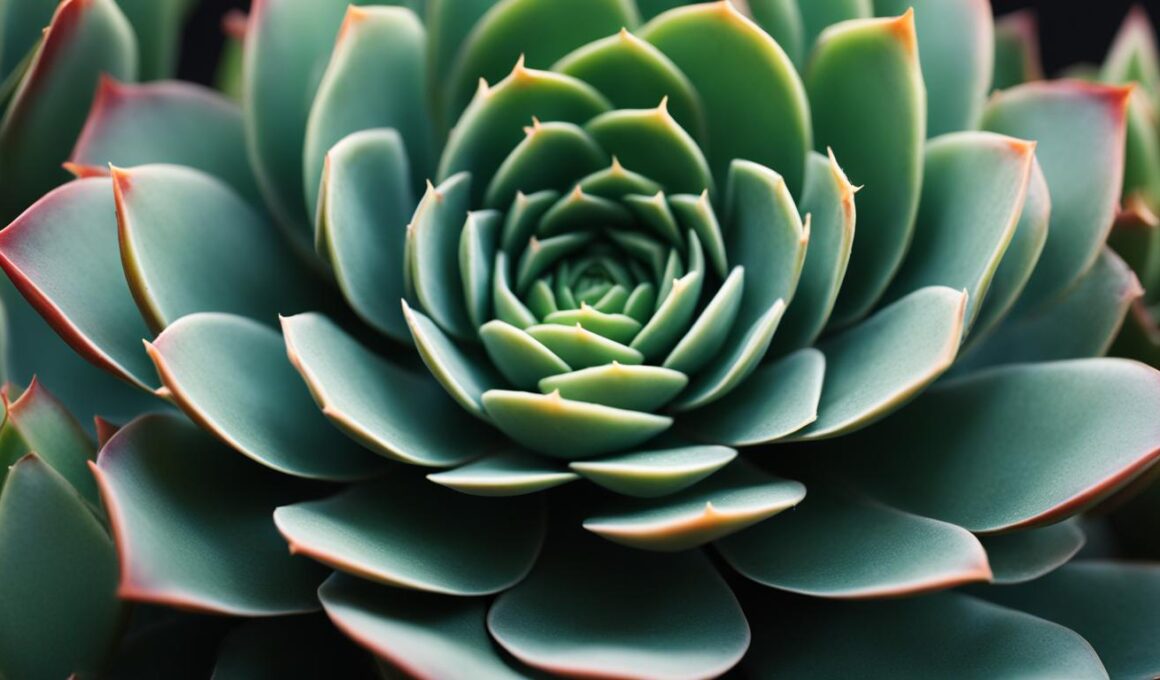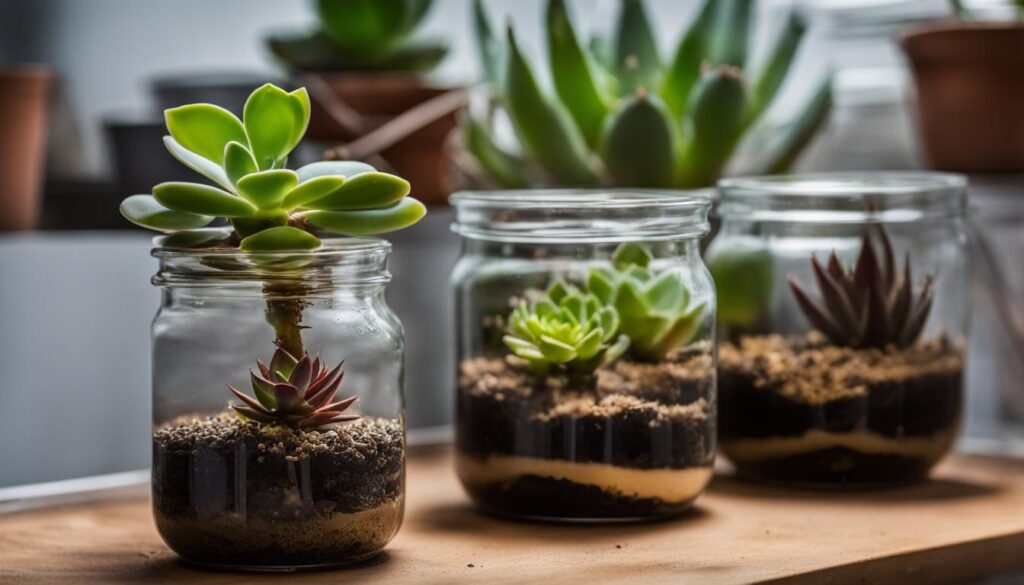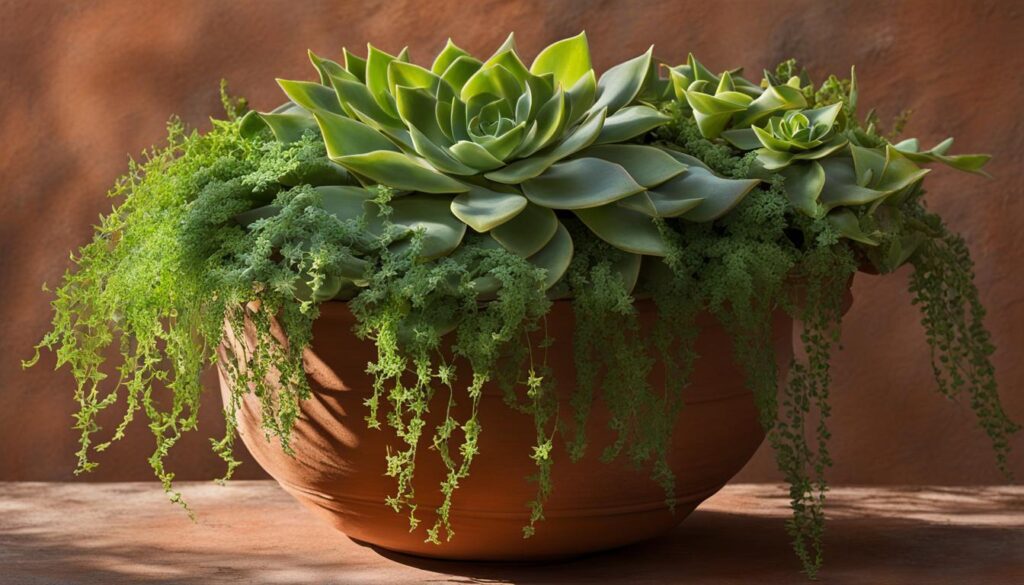Succulent plants can sometimes grow long, leggy stems. This can happen naturally over time, or it can be a response to low light conditions or a search for sunlight. When succulent stems become bare, the leaves will not grow back, and the plant needs to be cut back and propagated using stem cuttings. Here is a guide on how to care for succulents with long stems and what to do to propagate them.
Post Summary
- Succulent stems can grow long and leggy due to natural growth, low light conditions, or a search for sunlight.
- Some succulent varieties are more prone to leggy growth and may require regular pruning to maintain their shape.
- When succulent stems become bare, cuttings can be taken and propagated to create new plants.
- Proper care for succulents with long stems includes pruning, providing adequate lighting, and using well-draining soil.
- Succulents with long stems can be used to create cascading or trailing arrangements.
Why Do Succulent Stems Grow Long?
Succulent stems can sometimes grow long and leggy, which may detract from their overall appearance. Understanding the reasons behind this growth can help you address the issue and take appropriate measures to care for your succulents.
One common reason for leggy succulent stems is the search for sunlight. Succulents are typically sun-loving plants and will stretch their stems to reach for more light if they are not receiving enough. This can happen if the succulent is placed in a location with inadequate sunlight or if it is overshadowed by other plants.
Another cause of leggy growth is low light conditions. Succulents need bright, indirect light to thrive, and when they don’t get enough light, their stems may elongate in an attempt to find it. This can happen indoors when succulents are placed too far from a window or in a room with insufficient natural light.
Causes of Leggy Succulent Stems:
- Search for sunlight
- Low light conditions
To prevent leggy growth in succulents, it is important to provide them with the right amount of light. Place your succulents in a location where they can receive bright, indirect light for at least a few hours each day. If you are growing succulents indoors, consider using artificial grow lights to supplement natural light.
When succulent stems do become long and leggy, pruning and propagation are often necessary. By cutting back the stems and propagating new plants from the cuttings, you can help maintain a more compact and aesthetically pleasing appearance. Taking the time to address the causes of leggy succulent growth and implementing proper care techniques will ensure the health and beauty of your succulent collection.
| Succulent Species | Lighting Requirements |
|---|---|
| Monadenium Ritchiei | Bright indirect light |
| Smooth Agave | Full sun to partial shade |
| Morning Beauty Echeveria | Bright indirect light |
| Maguey Pulquero | Full sun to partial shade |
| Dwarf Jade Plant | Bright indirect light |
How to Identify Succulents that Grow Long Stems
Not all succulents will naturally grow long stems. Some varieties are known for their leggy growth habit. Here are some succulents that are more likely to develop long stems:
- Monadenium Ritchiei
- Smooth Agave
- Morning Beauty Echeveria
- Maguey Pulquero
- Dwarf Jade Plant
- Wax Ivy or Natal Ivy
- Burro’s Tail
- String of Dolphins
- True Christmas Cactus
- Hoya Plant
- Rattail Cactus
- String of Buttons
- Paintbrush Flower
- Sedum Cuspidatum
- Frosty Morn Sedum
- October Daphne Stonecrop
- Jade Plant
- Yucca
These succulents may require regular pruning to keep their shape or can be used to create cascading or trailing arrangements.
Why Some Succulents Develop Long Stems
Understanding the reasons why succulents develop long stems can help you better care for these plants. Some succulents naturally grow leggy over time and need to be pruned to maintain their compact form. Others may stretch their stems in search of sunlight or due to low light conditions. By identifying the species that tend to have elongated stems, you can provide the appropriate care and maintenance to keep your succulents healthy and flourishing.
It’s important to note that long stems can be both a natural characteristic of certain succulents and a sign of potential issues such as inadequate light or nutrient deficiencies. Regular observation and care can help you keep your succulents thriving and prevent leggy growth.
How to Care for Succulents with Long Stems?
If you have succulents with long stems, it’s important to provide them with proper care to ensure their health and vitality. Here are some essential tips for caring for succulents with long stems:
- Pruning: Regular pruning is crucial for maintaining the shape and compactness of succulents with long stems. Use clean and sharp pruning tools to carefully trim back the leggy growth. Pruning should be done during the active growing season to encourage new growth.
- Propagation: Propagating succulents through stem cuttings is an effective way to create new plants and rejuvenate leggy succulents. After pruning the long stems, allow the cuttings to callus over for a few days. Then, plant them in a well-draining succulent and cactus mix and provide bright, indirect light. Within a couple of months, the cuttings should root and grow into new plants.
- Lighting: Succulents with long stems may require better lighting conditions to prevent further stretching. Place them in a location with bright, indirect light or use artificial grow lights to provide adequate illumination. Avoid exposing them to direct sunlight, as it can cause sunburn and damage the leaves.
- Watering and Soil: Succulents with long stems prefer well-draining soil and infrequent watering. Use a specialized succulent and cactus mix that allows excess water to drain out quickly. Water the plants thoroughly but allow the soil to dry out completely between waterings to prevent root rot.
By following these care tips, you can help your succulents with long stems thrive and maintain their beautiful form. Remember to adjust your care routine based on the specific needs of each succulent variety, as some may have slightly different requirements.
Common Care Tips for Succulents with Long Stems
| Care Aspect | Tips |
|---|---|
| Pruning | Regularly trim back leggy growth during the active growing season to maintain shape and promote new growth. |
| Propagation | Propagate succulents through stem cuttings by allowing the cuttings to callus over and then planting them in well-draining soil. |
| Lighting | Place succulents in a location with bright, indirect light or provide artificial grow lights to prevent further stretching. |
| Watering and Soil | Use a well-draining succulent and cactus mix and water thoroughly but infrequently, allowing the soil to dry out completely between waterings. |
Propagating Succulents from Long Stem Cuttings
One of the best ways to propagate succulents with long stems is through stem cuttings. This process allows you to create new plants from the healthy parts of your existing succulents. Propagating succulents from stem cuttings is a relatively simple and rewarding process that can yield impressive results. Here’s a step-by-step guide on how to propagate your succulents:
- Cut a healthy stem: Choose a stem that is long and healthy, without any signs of damage or disease. Use a clean, sharp knife or shears to cut the stem at an angle, making sure the cutting is at least a few inches long.
- Let the cutting callus: After cutting the stem, place the cutting in a dry location out of direct sunlight. Allow the cut end to callus over for a few days. This helps prevent rotting when the cutting is planted.
- Prepare the planting medium: While the cutting is callusing, prepare a well-draining soil mix for planting. A mix specifically formulated for succulents and cacti is ideal. Fill a pot or container with the soil mix, leaving enough space for the cutting to be inserted.
- Plant the cutting: Once the cutting has calloused, gently insert it into the soil mix, burying the cut end about an inch into the soil. Firmly press the soil around the cutting to provide support.
- Provide ideal growing conditions: Place the newly planted cutting in a bright, indirect light location. Avoid direct sunlight, as this can cause the cutting to dry out. Water sparingly, allowing the soil to dry out between waterings. Within a few weeks to a couple of months, the cutting should develop roots and start growing into a new plant.
Propagating succulents from stem cuttings is a great way to expand your succulent collection and share plants with friends and family. It is a simple and rewarding process that allows you to create new plants while also helping to maintain the shape and health of your existing succulents.
By following these steps and providing the right care, you can successfully propagate succulents from long stem cuttings and enjoy the beauty of these versatile plants.
Pruning Techniques for Succulents with Long Stems
When it comes to caring for succulents with long stems, pruning is an essential technique to maintain their health and promote new growth. Proper pruning not only helps shape the plant but also prevents leggy stems from becoming unruly. Here are some effective pruning techniques to keep your succulents looking their best:
1. Regular Trimming:
Succulents with long stems benefit from regular trimming to maintain a compact form. Use clean and sharp pruning tools, such as scissors or gardening shears, to make clean cuts. Trim the stems at a slight angle, just above a leaf node or joint. This technique encourages the growth of new branches and helps the plant maintain a more compact shape.
2. Pinching:
Another effective technique for shaping succulents with long stems is pinching. Pinching involves using your fingers to pinch off the tips of the stems. This not only removes the leggy growth but also encourages branching. Pinch the stems just above a leaf node or joint to stimulate new growth from that point. This technique is particularly useful for trailing succulents that tend to grow long stems.
3. Propagation by Cuttings:
When you prune succulents with long stems, don’t let the trimmed portions go to waste! Take advantage of the opportunity to propagate new plants. After making clean cuts, allow the cuttings to callus over for a few days. Once calloused, plant the cuttings in well-draining soil and mist them lightly. Within a few weeks, the cuttings will develop roots and grow into new plants.
| Pruning Technique | Benefits |
|---|---|
| Regular Trimming | Maintains compact form |
| Pinching | Encourages branching |
| Propagation by Cuttings | Create new plants |
By employing these pruning techniques, you can shape your succulents with long stems and keep them looking aesthetically pleasing. Remember to prune during the active growing season and avoid pruning during the dormant period. With a little care and attention, your succulents will thrive and continue to add beauty to your indoor or outdoor space.
Transferring Succulents with Long Stems to a New Location
If your succulent with long stems is not receiving enough sunlight in its current location, consider moving it to a new spot with better lighting conditions. Succulents thrive in bright, indirect light, and lack of sunlight can cause leggy growth. When moving a succulent, give it time to acclimate to the new environment before watering or fertilizing.
Here are some steps to follow when transferring your succulents to a new location:
- Choose an appropriate location: Look for an area that receives bright, indirect light throughout the day. Avoid direct sunlight as it can scorch the leaves of succulents.
- Prepare the new container: Select a well-draining pot with drainage holes to prevent water from pooling at the bottom. Fill the pot with a succulent and cactus mix, ensuring it is free of any contaminants or pests.
- Gently remove the succulent: Carefully loosen the soil around the base of the succulent and gently lift it out of the old container. Be cautious not to damage the roots or break any stems.
- Replant the succulent: Place the succulent in the new container, making sure it is at the same depth as it was in the previous pot. Add or remove soil as needed to achieve the proper height.
- Allow for acclimatization: After replanting, give the succulent some time to adjust to its new environment. Avoid watering for the first few days to allow the roots to settle and prevent excess moisture.
Remember, each succulent has its own light requirements, so it’s essential to research the specific needs of your plant and choose a suitable location accordingly. By providing the optimal lighting conditions, you can encourage healthy growth and prevent leggy stems.
Watering and Soil Mix for Succulents with Long Stems
Proper watering and soil mix are crucial for the health of succulents with long stems. These plants have specific needs when it comes to moisture and soil drainage. Here are some watering tips and soil mix recommendations to ensure your succulents thrive:
Watering Tips
- Water sparingly: Succulents are adapted to arid conditions and prefer infrequent but deep watering. Allow the soil to dry out completely between waterings to prevent root rot.
- Check the soil moisture: Before watering, check the moisture level of the soil by sticking your finger about an inch into the soil. If it feels dry, it’s time to water. If it’s still moist, wait a few more days.
- Water at the base: Avoid watering the leaves or stems of succulents, as this can lead to rot. Instead, water directly at the base of the plant to target the roots.
- Use a watering schedule: Depending on the climate and environmental conditions, establish a watering schedule that suits your succulents. In general, water once every 1-2 weeks during the growing season, and reduce frequency in winter when the plants are dormant.
Well-Draining Soil Mix
Succulents require a soil mix that allows for excellent drainage. Here’s a simple recipe for a well-draining succulent soil mix:
Mix equal parts of:
- Succulent or cactus potting mix
- Coarse sand or pumice
- Perlite or crushed granite
This combination creates a light and porous soil mix that allows excess water to drain away quickly, preventing waterlogged roots.
When repotting your succulents, make sure to use this well-draining soil mix and choose a pot with drainage holes to further ensure good drainage. Remember to adjust your watering schedule according to the specific needs of your succulents and the environmental conditions they are in. With proper watering and a well-draining soil mix, your succulents will thrive and display their beautiful long stems.
| Watering Tips for Succulents with Long Stems | Well-Draining Succulent Soil Mix |
|---|---|
| – Water sparingly | – Succulent or cactus potting mix |
| – Check soil moisture before watering | – Coarse sand or pumice |
| – Water at the base, not on leaves or stems | – Perlite or crushed granite |
| – Establish a watering schedule |
Best Succulents for Cascading and Trailing Arrangements
If you’re looking to add some visual interest and variety to your succulent collection, consider incorporating cascading and trailing succulents. These plants have long stems that gracefully drape over the edges of containers or hang down from elevated positions, creating a stunning display. Here are some of the best succulents for cascading arrangements:
- Burro’s Tail (Sedum morganianum): This succulent has long, trailing stems covered in plump, bead-like leaves. It adds a touch of elegance to any arrangement.
- String of Dolphins (Senecio peregrinus): With its unique leaf shape resembling leaping dolphins, this succulent is sure to become a conversation starter in your display.
- Rattail Cactus (Aporocactus flagelliformis): This succulent has long, thin stems that resemble the tail of a rat. It produces beautiful pink flowers, adding a pop of color to your arrangement.
- String of Buttons (Crassula perforata): The stacked, button-like leaves of this succulent create a cascading effect, making it a great choice for hanging baskets or tall containers.
These succulents are not only visually appealing but also relatively low-maintenance, making them perfect for both indoor and outdoor spaces. Their trailing stems can be showcased in hanging baskets, allowed to spill over the edges of pots, or incorporated into vertical gardens for a stunning vertical display.
Succulent Varieties for Cascading Arrangements
| Succulent Varieties | Key Features |
|---|---|
| Burro’s Tail (Sedum morganianum) | Long, trailing stems covered in plump, bead-like leaves |
| String of Dolphins (Senecio peregrinus) | Leaves resembling leaping dolphins |
| Rattail Cactus (Aporocactus flagelliformis) | Long, thin stems with pink flowers |
| String of Buttons (Crassula perforata) | Stacked, button-like leaves |
When creating cascading arrangements with these succulents, ensure that the containers have proper drainage to prevent waterlogged soil. Use a well-draining succulent and cactus mix to provide the ideal growing conditions. Place the arrangement in a bright, indirect light location, as direct sunlight may scorch the leaves.
Remember to adjust your watering schedule according to the needs of each succulent variety. Allow the soil to dry out between waterings, as overwatering can lead to root rot. With proper care and attention, your cascading succulent arrangement will thrive and become a beautiful focal point in your living space.
Styling Ideas and Care Tips for Succulents with Long Stems
If you have succulents with long stems, you have a wonderful opportunity to create stunning displays and showcase their unique aesthetics. Whether you’re looking to spruce up your indoor space or add visual interest to your outdoor garden, here are some styling ideas and care tips to help you make the most of your succulents with long stems.
1. Hanging Baskets and Vertical Gardens
Succulents with long stems are perfect for hanging baskets or vertical gardens. Their trailing nature allows them to cascade gracefully, creating an eye-catching display. Choose a variety of succulents with different colors, textures, and growth habits to create a visually appealing arrangement. Hang the baskets or arrange the plants vertically on a wall or trellis to add a touch of natural beauty to any space.
2. Incorporating Trailing Succulents in Bookshelves
Add a touch of greenery to your bookshelves by incorporating trailing succulents with long stems. Place small pots or planters on the shelves, allowing the stems to drape down. This creates a striking contrast to the vertical lines of the books and adds a fresh and vibrant element to your home decor.
3. Mixing Succulents with Other Plants
Don’t be afraid to mix succulents with other types of plants to create an interesting and dynamic composition. Combine succulents with long stems with plants of varying heights, leaf shapes, and colors to create a visually captivating arrangement. Experiment with different combinations until you achieve a harmonious and visually pleasing display.
In terms of care, succulents with long stems require proper lighting, well-draining soil, and careful watering. Ensure that they receive bright, indirect light for several hours each day. Use a well-draining succulent and cactus mix to prevent root rot and allow the soil to dry out between waterings. Remember to adjust your watering schedule based on the specific needs of each succulent and the environmental conditions.
By incorporating these styling ideas and following the care tips, you can create stunning arrangements with your succulents with long stems. Enjoy the beauty and versatility of these unique plants and let your creativity shine!
Common Issues and Troubleshooting for Succulents with Long Stems
While succulents with long stems can be stunning additions to your plant collection, they may also come with their own set of challenges. Here are some common problems that you may encounter with leggy succulents and tips on how to troubleshoot them:
1. Weak or Yellowing Stems and Leaves
If your succulent’s stems and leaves are weak or turning yellow, it could be a sign of inadequate light. Succulents need bright, indirect sunlight to thrive. Consider moving your plant to a location with more natural light, such as near a south-facing window. Alternatively, you can provide artificial grow lights to supplement the light requirements.
2. Root Rot
Succulents are vulnerable to root rot if they are overwatered or planted in a soil mix that retains too much moisture. To prevent root rot, ensure that your succulents are potted in a well-draining soil mix specifically formulated for cacti and succulents. Allow the soil to dry out completely between waterings, and be cautious not to water too frequently.
3. Pests
Common pests that can affect succulents include mealybugs, aphids, and spider mites. If you notice tiny bugs crawling on your plant or sticky residue on the leaves, it’s likely that you have a pest infestation. Treat the affected plant with a natural insecticidal soap or neem oil, following the manufacturer’s instructions. Quarantine the plant to prevent the pests from spreading to other succulents.
4. Overcrowding and Lack of Air Circulation
If you have multiple succulents growing closely together, they may become overcrowded, leading to poor air circulation and increased risk of disease. To avoid this issue, ensure that each succulent has enough space to grow and receive proper airflow. If necessary, repot your plants into individual containers with adequate drainage.
| Issue | Troubleshooting |
|---|---|
| Weak or Yellowing Stems and Leaves | Move the succulent to a location with more light or provide artificial grow lights. |
| Root Rot | Ensure the succulent is potted in a well-draining soil mix and water sparingly. |
| Pests | Treat the affected plant with natural insecticidal soap or neem oil. |
| Overcrowding and Lack of Air Circulation | Repot the succulent into a separate container with proper drainage. |
By addressing these common issues and providing the necessary care, you can help your succulents with long stems thrive and maintain their beauty. Remember to observe your plants closely and make adjustments as needed to ensure their overall health and vitality.
Conclusion
In conclusion, succulents with long stems can be a stunning addition to any plant collection. Whether they naturally grow leggy or stretch their stems in search of sunlight, these plants require special care to maintain their health and aesthetics.
Pruning is an essential technique for managing leggy succulents. By cutting back the stems and propagating the plant through stem cuttings, you can rejuvenate the succulent and create new plants. It is important to use clean and sharp pruning tools and perform the pruning during the active growing season.
Proper lighting and watering are also crucial for succulents with long stems. These plants thrive in bright, indirect light and require a well-draining soil mix to prevent root rot. Adjust your watering schedule based on the specific needs of the succulent and the environmental conditions.
Lastly, experiment with different arrangements and display ideas to showcase the unique beauty of succulents with long stems. Whether in hanging baskets, trailing down bookshelves, or incorporated into vertical gardens, these plants can create visually appealing displays. With the right care and styling, your leggy succulents will continue to thrive and bring joy to your space.
Can Succulents with long stems still have the same benefits as other succulent plants?
Yes, succulents with long stems can still offer the same surprising succulent plant benefits as other varieties. Despite their different appearance, they still have the ability to store water, improve air quality, and add a touch of greenery to indoor spaces.
FAQ
Why do succulent stems grow long?
Succulent stems can grow long naturally over time or in response to low light conditions or a search for sunlight.
How can I identify succulents that grow long stems?
Some succulents are more likely to develop long stems, such as Monadenium Ritchiei, Morning Beauty Echeveria, and Burro’s Tail.
How do I care for succulents with long stems?
Proper care includes pruning the stems to promote new growth, propagating the plant through stem cuttings, and providing adequate lighting and watering.
How do I propagate succulents from long stem cuttings?
After pruning the long stems, allow the cuttings to callus over for several days before planting them in a well-draining succulent and cactus mix.
What pruning techniques should I use for succulents with long stems?
Use clean and sharp pruning tools to make straight or angled cuts during the active growing season, promoting new growth and shaping the plant.
How do I transfer succulents with long stems to a new location?
If the current location lacks sunlight, consider moving the succulent to an area with better lighting conditions, ensuring it acclimates before watering or fertilizing.
How should I water and what soil mix should I use for succulents with long stems?
Succulents with long stems require well-draining soil, so use a succulent and cactus mix and water sparingly, allowing the soil to dry out between waterings.
What are the best succulents for cascading and trailing arrangements?
Burro’s Tail, String of Dolphins, Rattail Cactus, and String of Buttons are popular succulents for cascading arrangements due to their trailing stems.
What are some styling ideas and care tips for succulents with long stems?
Experiment with different arrangements and display ideas while providing adequate lighting and proper care to ensure the health and longevity of your succulent arrangements.
What common issues and troubleshooting should I be aware of for succulents with long stems?
Watch out for issues such as yellowing or wilting leaves, root rot, overwatering, and pests, and take prompt action to prevent further damage and maintain the health of your succulents.












